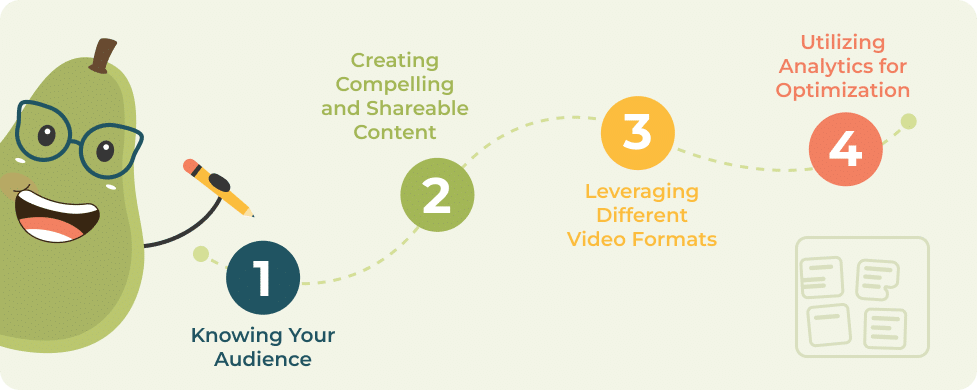The digital marketing landscape continually evolves, but one aspect that’s not just a trend but a necessity is video content. Video content marketing is a powerful tool that can significantly impact audience engagement, brand visibility, SEO, and conversion rates.
Understanding and mastering video content marketing is crucial for marketers, content creators, and small business owners to stay ahead in the online game. This comprehensive guide will walk you through the fundamentals, strategies, and actionable steps to elevate your video marketing game.
What is Video Content Marketing?

Videos can be used in various contexts, including on your website and landing pages, email campaigns, social media, and more. Video content’s flexibility allows it to be leveraged at every stage of the customer’s buying process.
Importance in the Digital Landscape
In light of this, businesses and marketers need to prioritize creating and distributing video content. Platforms such as YouTube, Instagram, and TikTok offer unique opportunities to reach diverse audiences, each with its preferences and consumption habits. Crafting personalized, informative, and captivating video content tailored to these platforms can significantly enhance visibility and engagement.
Additionally, integrating videos into websites and blogs can improve SEO rankings, drive more organic traffic, and foster a strong brand presence online.
Benefits of Video Content Marketing
Increased Engagement
This adaptability enhances video content’s effectiveness in engaging a diverse audience base, making it a crucial tool in cutting through the digital noise and capturing the fleeting attention of consumers.
Improved Brand Visibility
The visual and auditory stimulation videos enhance memory retention about your brand and further elevate its visibility in the crowded digital marketplace.
Implementing a consistent brand voice and aesthetic in your videos can reinforce brand recognition and establish a distinctive presence that stands out to consumers.
Enhanced SEO
The duration of videos is also essential. By increasing the time visitors spend on your website, search engines interpret your site as more valuable, boosting your rankings. Improving your content, including transcripts of your videos, can make your content more accessible and indexable by search engines, further enhancing your SEO efforts.
Sharing your video content on social media and other platforms can also generate backlinks to your site, a crucial factor in SEO.
Strategies for Successful Video Content Marketing

To take advantage of the benefits of video content marketing, you need a smart strategy that is tailored to your audience and your company’s goals. This strategy should be tailored to your situation and your goals, but you can start with these basics:
Knowing Your Audience
For instance, if analytics reveal a high engagement with how-to videos on your platform, it would be beneficial to focus on creating more instructional content that addresses the needs and curiosities of your audience.
Additionally, understanding demographic information such as age, location, and language preferences can help craft messages that resonate more deeply with your viewers.
Creating Compelling and Shareable Content
Shareability is critical to expanding your organic reach and potentially achieving virality. To create shareable content, focus on relatability, timeliness, and emotional impact. For example, a video that taps into current trends provides a fresh perspective, evokes laughter, or evokes empathy is more likely to be shared.
Moreover, encouraging viewers to engage with the content through likes, comments, and shares can foster a community around your brand, increasing loyalty and advocacy.
Leveraging Different Video Formats
- Live videos can offer real-time engagement with your audience, while Instagram stories provide a platform for more casual and spontaneous content.
- Tutorials can educate and add value, and VR or 360 videos can offer immersive experiences that captivate viewers.
Each format has its strengths and can cater to different audience segments. Diversifying your video content keeps your audience intrigued and looking forward to what’s next. It’s essential to consider which formats align with your brand identity and goals and the technical capabilities and resources available to you.
Utilizing Analytics for Optimization
Analyzing metrics such as watch time, click-through rate, and engagement rate can help you fine-tune your video content for better performance. For instance, if analytics show viewers dropping off after the first minute, consider creating shorter, more concise videos.
Additionally, A/B testing different video thumbnails, titles, and descriptions can help you understand what captures your audience’s attention. Use these insights to guide your content strategy, ensuring that your videos attract viewers and keep them engaged and coming back for more.
Ultimate Guide to Implementing Video Content Marketing
Implementing a video content marketing strategy is a multifaceted process that begins with the planning stages and continues through to the measurement and analysis of your campaign’s performance.
Setting Clear Goals
- If your goal is to increase sales, your videos should include compelling calls-to-action and link directly to your product pages.
- If brand awareness is your target, your content should be designed to be memorable and shareable to maximize reach.
- Educating your audience might involve creating tutorial-style videos that provide valuable information in an engaging format.
Choosing the Right Platform
- YouTube, with its vast user base, is ideal for long-form content and has robust analytics tools.
- Instagram is perfect for shorter, more visually engaging content, and its stories feature allows for a more personal connection with viewers.
- Even LinkedIn caters to a professional audience and is suitable for educational and company culture videos.
Crafting a Content Calendar
Your calendar should detail when and where each video will be published and align with your overall marketing strategy, including product launches, seasonal campaigns, or other significant business milestones.
A content calendar also lets you plan for variety, preventing audience fatigue. It’s a dynamic tool that should be regularly reviewed and adjusted to reflect performance data and emerging trends, ensuring your video content remains fresh and relevant.
Measuring Success and Adjusting Strategies
- Number of Clicks: Measures the reach of your video and how many times it’s been clicked on.
- Video Engagement: Includes metrics like comments, likes, and shares to gauge how viewers interact with your video.
- Bounce Rates: Indicates at what point viewers stop watching your video.
- View-Through Rates: Shows the percentage of the video watched by viewers.
- Social Media Shares: Counts how often your video has been shared across social media platforms.
- Returning Users: Tracks how many viewers return to watch more of your videos.
- Video Conversion Rates: Measures how effectively your video leads to a desired action, such as a purchase or sign-up.
- Unique Users: Counts the number of distinct viewers who watch your video.
- Consideration Lift: Measures the impact of your video on viewers’ perception of your brand or product.
These metrics can help you understand what resonates with your audience and doesn’t. For example, many shares might indicate your content is relatable and engaging, while a low watch time could suggest the need for more captivating beginnings.
Use this data to iterate on your content, experimenting with different formats, lengths, and storytelling techniques. Be prepared to pivot your strategy based on these insights, continually optimizing your approach to video content marketing for better results.
Quick step-by-step on how to create videos for digital platforms
3
4
5
for your videos.



